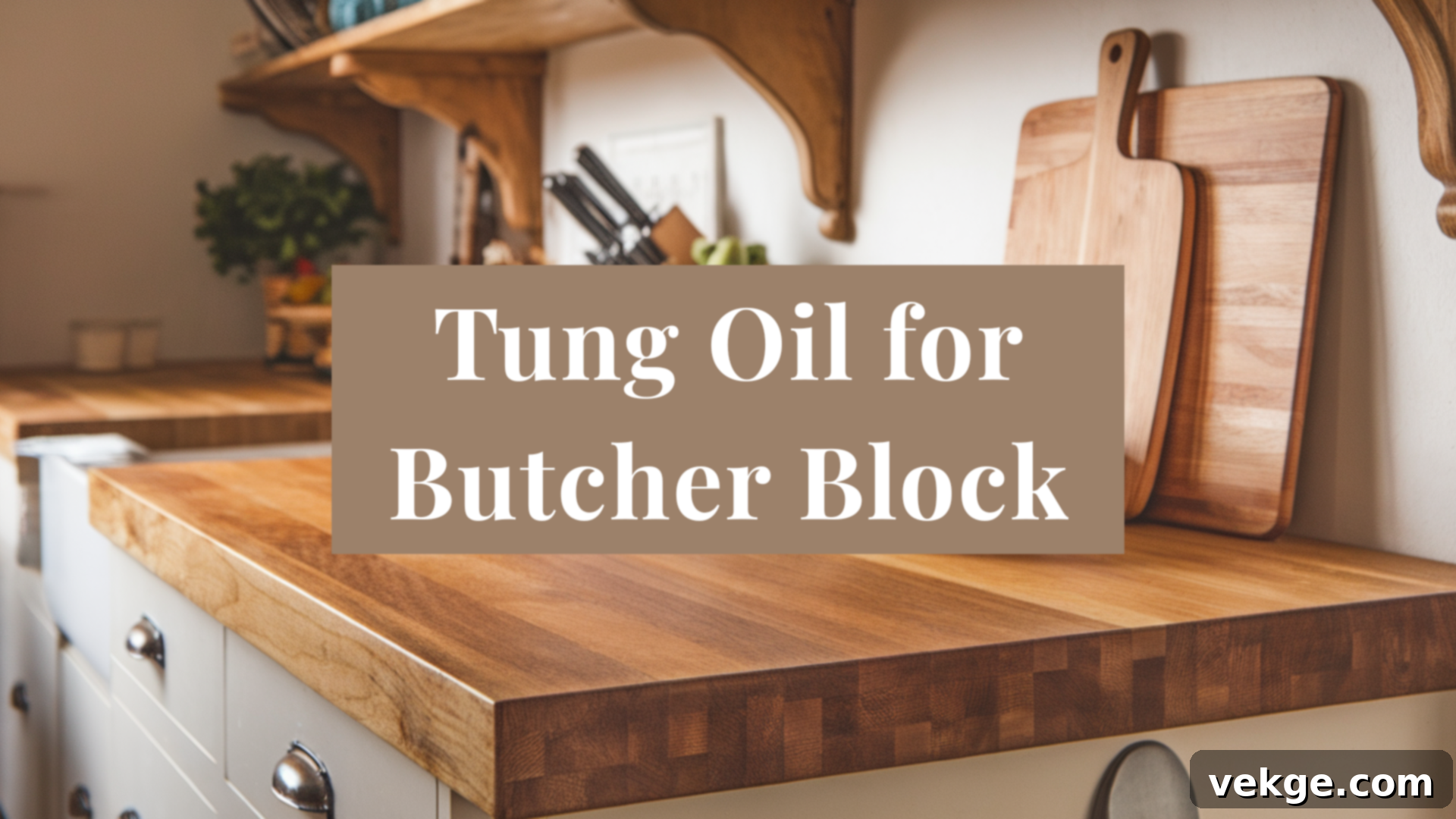Mastering Tung Oil for Butcher Block Countertops: A Comprehensive Guide to Food-Safe Wood Protection
Imagine running your hand across a warm, smooth wooden countertop, its natural grain glowing, knowing it’s not only beautiful but also completely safe for preparing your family’s meals. This isn’t just a dream – it’s the reality you can achieve with tung oil. Often hailed as the ultimate natural finish for butcher block countertops, tung oil offers unparalleled protection and aesthetic appeal, and it’s far easier to use than you might initially think.
My own journey with tung oil began with a bit of trepidation. The first time I stood before my brand-new maple butcher block, can of tung oil in hand, I felt the weight of getting it just right. Yet, the process was remarkably intuitive, and the transformation was nothing short of amazing. The wood deepened in color, its intricate patterns coming to life under the rich, matte finish. It became clear that this wasn’t just a treatment; it was an enhancement.
In this comprehensive guide, we’ll delve into everything you need to know about using pure tung oil for your butcher block countertops. From understanding what makes this natural finish truly special to mastering the application process like a seasoned pro, and discovering simple yet effective maintenance tips, you’ll gain the confidence to protect your investment. These insights will empower you to create a durable, highly water-resistant, and proudly food-safe surface that not only withstands the rigors of daily use but genuinely improves with age, becoming a cherished centerpiece of your kitchen for countless meals to come.
What is Pure Tung Oil? A Natural, Durable Wood Finish
Tung oil, derived from the seeds of the tung tree (Vernicia fordii), which flourishes in China and other parts of Asia, has been a revered wood protector for centuries. It’s an all-natural, drying oil, distinct from many synthetic finishes. The oil is expeller-pressed from tung nuts, yielding a clear to pale amber liquid that carries a mild, earthy scent, a stark contrast to the harsh chemical odors of many varnishes.
Its enduring popularity stems from its unique ability to penetrate deep into wood fibers, polymerizing as it cures to form a flexible, tough, and highly water-resistant barrier from within. Unlike surface finishes that sit on top of the wood and can chip or peel, tung oil integrates with the wood, enhancing its natural beauty rather than obscuring it. This results in a desirable matte to satin finish that feels incredibly smooth and natural to the touch, highlighting the wood’s inherent grain and character without imparting an artificial gloss.
A key differentiator for butcher block applications is its food-safe nature. Pure tung oil is non-toxic once fully cured, making it an ideal choice for surfaces that will come into contact with food, such as cutting boards, wooden bowls, and, of course, butcher block countertops. This makes it a preferred finish for health-conscious homeowners and professional woodworkers alike. Its eco-friendly profile, coupled with its ability to offer robust protection and a rich, warm aesthetic that deepens with time, solidifies tung oil’s reputation as a premium, natural wood finish.
It’s important to distinguish between pure tung oil and products labeled “tung oil finish.” Many “tung oil finishes” are actually diluted varnishes or oil/resin blends that may contain petroleum distillates and other chemicals, meaning they are not always food-safe or natural. For butcher blocks, always ensure you are using 100% pure tung oil to guarantee its non-toxic properties and the authentic benefits described here.
How to Finish Butcher Block Countertops with Tung Oil: A Step-by-Step Guide
Transforming your butcher block countertops into stunning, protected surfaces with tung oil is a rewarding process that requires patience but yields incredible results. Follow these detailed steps to achieve a durable, food-safe finish that will stand the test of time.
Preparation and Sanding: The Foundation for a Perfect Finish
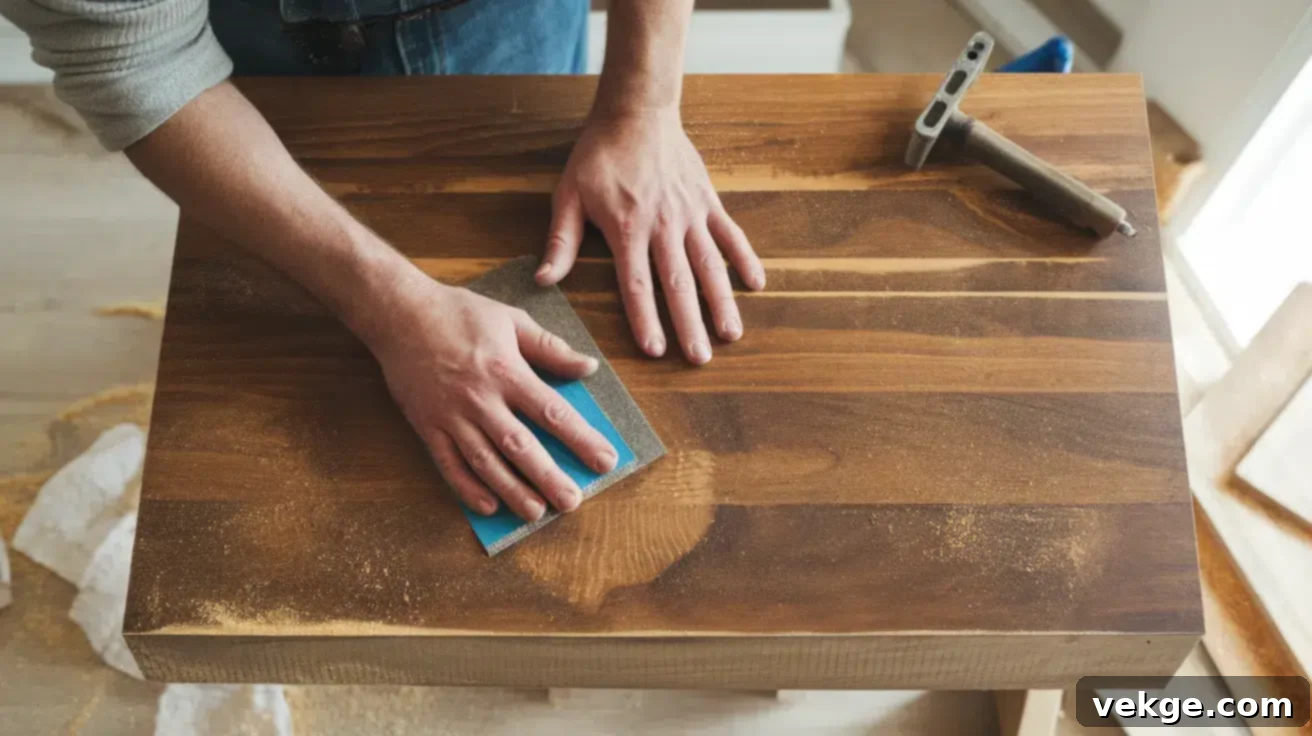
Proper preparation is paramount. The quality of your finish directly depends on the surface you’re working with. Begin by ensuring your countertop is meticulously clean and free of any previous finishes, waxes, or stubborn residues. Use a damp cloth to wipe away any dust, grease, or grime. Allow the wood to dry completely before proceeding.
- Initial Sanding: Start with 120 or 150-grit sandpaper to remove any deep scratches, mill marks, or imperfections. Always sand in the direction of the wood grain to avoid cross-grain scratches that will be visible later.
- Progressive Sanding: Gradually move to finer grits: 180-grit, then 220-grit, and finally 320-grit sandpaper. Each successive grit refines the surface, removing the microscopic scratches left by the previous one. The goal is a super smooth, almost glass-like surface. After the final 320-grit pass, run your hand across the wood – it should feel incredibly silky. This meticulous sanding ensures optimal oil penetration and a truly luxurious feel.
- Dust Removal: After each sanding stage, and especially after the final sanding, meticulously remove all dust. Use a vacuum cleaner, followed by a clean, lint-free cloth. For the most thorough cleaning, a tack cloth is invaluable for picking up even the finest dust particles. Any remaining dust can get trapped in the oil, resulting in a bumpy or cloudy finish.
Applying Tung Oil: Building Layers of Protection
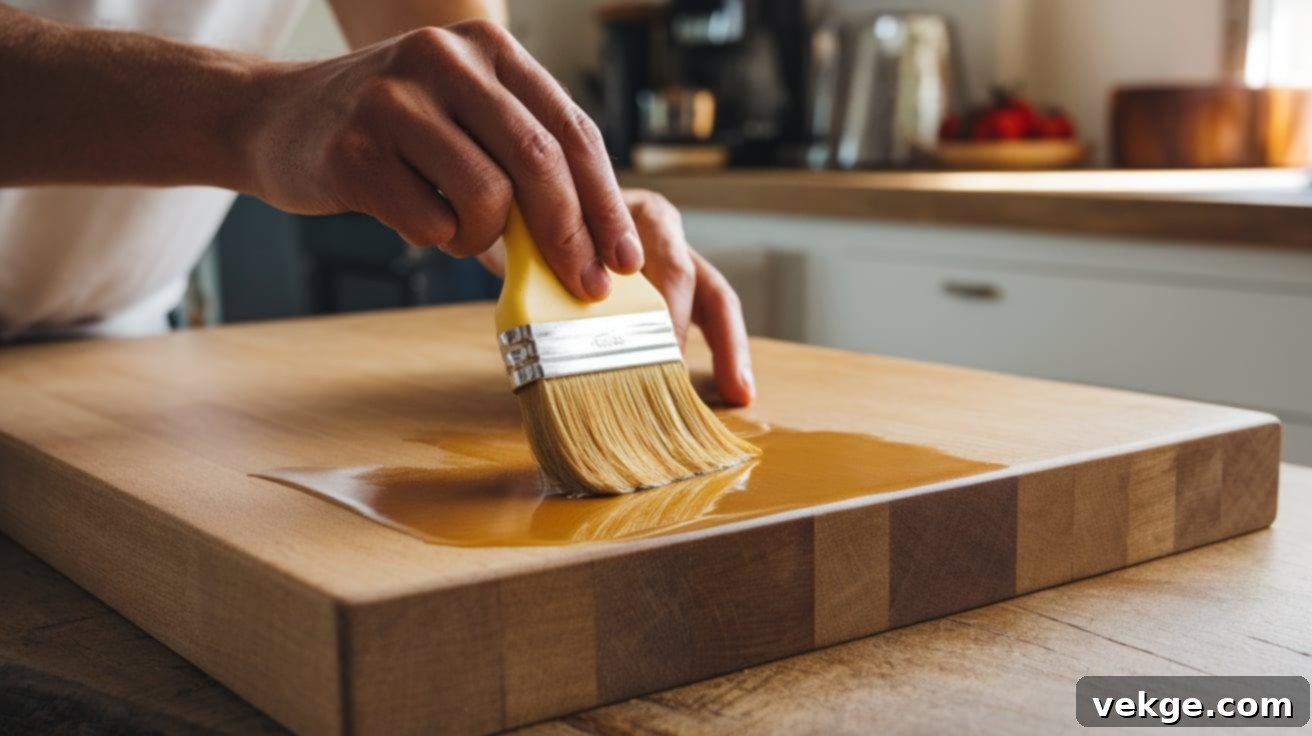
With your surface pristine, it’s time for the most satisfying part: applying the tung oil. Work in a well-ventilated area, ideally between 60-70°F (15-21°C) with moderate humidity for best results.
- First Coat (Penetration): For the very first coat, many experts recommend thinning the tung oil with a natural solvent like citrus solvent or mineral spirits (up to 50%) to improve penetration, especially for dense woods. Pour a small amount of oil onto the wood or a clean, lint-free cloth (old cotton t-shirts work excellently).
- Rubbing In: Generously rub the oil into the wood, working in small sections and using circular motions. Ensure the entire surface is saturated. Don’t be afraid to apply ample oil – the wood will only absorb what it can. For butcher block, ensure all sides, including edges and any cutouts, receive attention.
- Soak Time: Allow the oil to soak into the wood for approximately 20-30 minutes. During this time, the wood will absorb the oil deeply, drawing it into the cellular structure. You might notice some areas drying faster than others; reapply oil to these “thirsty” spots.
- Wipe Off Excess: This step is critical. After the soak time, use a fresh, clean, lint-free cloth to thoroughly wipe off *all* excess oil from the surface. If too much oil is left on top, it will cure into a sticky, gummy residue that is difficult to remove and detracts from the finish. The surface should feel dry to the touch, not oily or tacky.
- Drying Between Coats: Patience is key. Allow each coat to dry for at least 24-48 hours before applying the next, or even longer in humid conditions. A simple touch test will tell you if it’s ready. For robust protection on butcher blocks, aim for 4-7 coats, depending on the wood type and desired level of durability. Each subsequent coat will enrich the wood’s color and build upon the protective barrier. Lightly buffing with 0000 steel wool between coats can help achieve a smoother finish, but isn’t strictly necessary after the first few coats.
Safety Note: Rags soaked with tung oil can spontaneously combust. Always lay them flat to dry thoroughly outdoors or soak them in water before disposing of them in a sealed container.
Curing Process: The Final Step to Enduring Protection
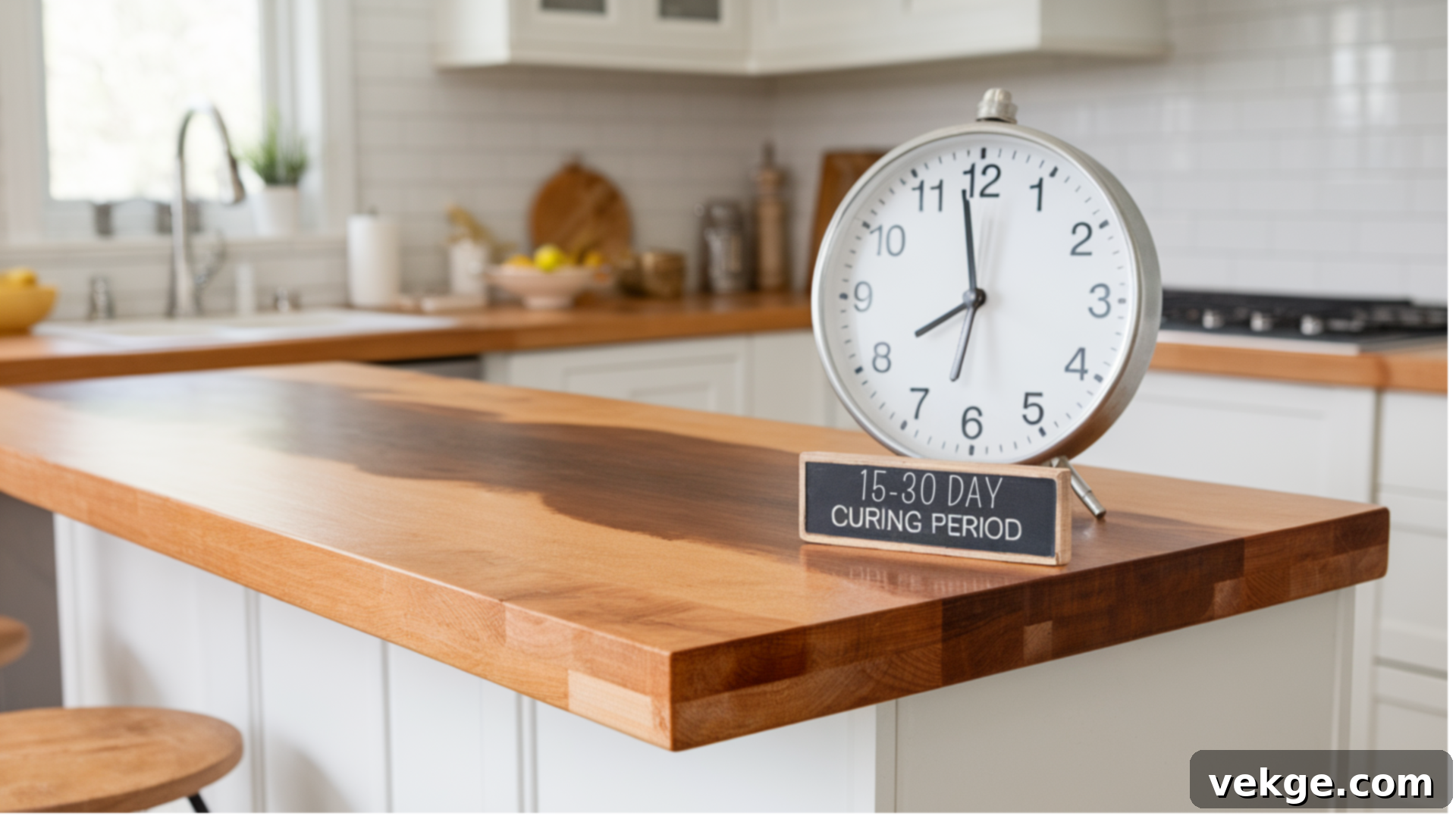
While your butcher block may feel dry to the touch after a few days, tung oil undergoes a natural polymerization process that requires significant time to fully cure and harden. This curing period is where the oil transforms from a liquid into a durable, protective resin within the wood fibers. The complete curing process typically takes 15 to 30 days, and sometimes even longer in cooler or more humid environments.
During this critical curing phase, it’s vital to treat your newly finished countertops with extreme care. Avoid placing heavy objects, cutting directly on the surface, or allowing standing water, hot pots, or pans to rest on the wood. While the surface might appear dry, it hasn’t reached its full hardness and could still be susceptible to dents, stains, or water rings. The wait can feel long, especially when you’re eager to use your beautifully finished kitchen, but a fully cured tung oil finish provides exceptional, long-lasting protection that makes the patience well worth it. This deep curing is what provides the superior water resistance and durability that tung oil is renowned for, ensuring your butcher block remains a functional and aesthetic asset for many years.
Pros and Cons of Using Tung Oil on Butcher Block: An Informed Decision
Choosing the right finish for your butcher block is a significant decision. Tung oil offers a unique set of advantages and disadvantages that should be carefully considered to ensure it aligns with your lifestyle and expectations for your kitchen countertops.
Pros: The Unrivaled Benefits of Tung Oil
Tung oil boasts a compelling array of benefits that make it a top contender for butcher block finishes:
- Food Safety: Foremost among its advantages, pure tung oil is completely non-toxic and food-safe once fully cured. This is crucial for butcher block, where food preparation is a daily activity, eliminating concerns about chemicals leaching into your meals.
- Exceptional Water Resistance: When properly applied and fully cured, tung oil creates a robust, waterproof barrier. This significantly protects your wood from moisture damage, spills, and the inevitable splashes that occur in a busy kitchen, preventing warping, cracking, and staining.
- Durability and Resilience: The polymerized finish within the wood makes it remarkably tough and resilient against daily wear and tear, including minor abrasions and impacts. Unlike surface coatings, it won’t chip or peel, maintaining its integrity over time.
- Natural Aesthetic Enhancement: Tung oil beautifully enhances the wood’s natural grain and color, imparting a warm, rich glow without creating an artificial plastic-like sheen. It provides a natural matte to satin finish that feels luxurious and authentic. My own maple butcher block still retains its fresh, natural appearance years later, deepening in character without yellowing or darkening excessively.
- Easy Repair and Maintenance: Unlike varnishes that require full stripping and refinishing for repairs, tung oil finishes are incredibly easy to maintain and repair. Minor scratches or worn spots can often be addressed by simply cleaning the area, lightly sanding, and reapplying a fresh coat of oil, seamlessly blending with the existing finish.
- Eco-Friendly and Low VOC: Pure tung oil is a natural, renewable resource, making it an environmentally conscious choice. It also has a very low VOC (Volatile Organic Compound) content, contributing to better indoor air quality compared to many synthetic finishes.
Cons: The Considerations and Trade-offs
While tung oil is excellent, it does come with certain aspects that might be considered drawbacks for some users:
- Lengthy Curing Time: This is arguably the biggest drawback. While dry to the touch in a day or two, tung oil requires a full 15-30 days to completely cure and achieve its maximum hardness and water resistance. This extended waiting period can be challenging, especially for a central kitchen element like countertops. I had to set up a temporary prep area for weeks, which required planning.
- Multiple Coats Required: Achieving adequate protection and a deep, rich finish typically requires 4-7 coats, applied over several days or weeks, depending on drying times. This multi-step process demands patience and consistency.
- Regular Reapplication: To maintain optimal protection and aesthetic appeal, tung oil finishes require reapplication, typically once or twice a year, depending on usage. While easy, it’s a commitment. Forgetting to re-oil can lead to dry spots that become more susceptible to stains and moisture penetration.
- Less Immediate Scratch Resistance: While durable, tung oil won’t provide the same immediate hard, impenetrable surface scratch resistance as a thick polyurethane layer. It’s more about resilience and reparability than an unyielding shield.
- Initial Odor: While generally mild and non-toxic, pure tung oil does have a distinct, slightly nutty or earthy odor during application and initial drying. This dissipates as it cures but can be noticeable in a closed environment.
After carefully weighing these factors, tung oil emerges as an excellent choice if your priorities are natural beauty, food safety, and repairability, and you are willing to invest the initial time for curing and commit to periodic maintenance. The enduring quality and aesthetic it provides often outweigh the temporary inconveniences for those who appreciate the true character of wood.
Tung Oil vs. Other Finishes for Butcher Blocks: A Comparative Analysis

When selecting a finish for your butcher block, the array of options can be overwhelming. Understanding how tung oil stacks up against common alternatives is crucial for making an informed decision tailored to your needs. Having experimented with various finishes over the years, I can attest that each has distinct strengths and weaknesses depending on the demands placed on your countertops.
|
Feature |
Tung Oil (Pure) |
Mineral Oil |
Beeswax (often with Mineral Oil) |
Polyurethane |
|
Food Safety |
Completely food-safe when cured |
Food-safe |
Food-safe |
Generally NOT food-safe for cutting surfaces; creates a barrier. |
|
Water Resistance |
Excellent when fully cured, deeply penetrates. |
Poor; sits on surface, needs very frequent reapplication. |
Moderate; provides a thin, temporary barrier. |
Excellent; creates a hard, impermeable surface film. |
|
Durability |
Good; flexible, won’t chip. Lasts 6-12 months between reapplications. |
Poor; provides minimal protection. Needs monthly reapplication, sometimes weekly. |
Moderate; slightly better than mineral oil alone, lasts 3-4 months. |
Excellent hard surface, but prone to chipping/scratching with heavy use and difficult to repair. |
|
Ease of Repair |
Easy; sand lightly and reapply to blend seamlessly. |
Very easy; simply reapply. |
Easy; reapply. |
Difficult; must sand down entire section (or even the whole surface) and refinish to avoid visible patches. |
|
Curing Time |
Long (15-30 days for full cure) |
None (absorbs immediately) |
Short (24-48 hours for wax to set) |
Moderate (3-7 days for full cure) |
|
Look & Feel |
Natural matte to satin, enhances grain, feels like wood. |
Very natural, matte, can look a bit “wet” initially. |
Natural with a slight sheen, smooth, waxy feel. |
Plastic-like, glossy finish, can obscure natural wood feel. |
|
Protection Level |
High (deep penetration, excellent water barrier) |
Low (primarily for aesthetic conditioning, minimal barrier) |
Moderate (forms a thin, temporary surface barrier) |
Very high (hard surface film) |
|
Toxicity During Application |
Low (mild, natural smell) |
None |
None |
High (strong fumes, requires good ventilation and PPE) |
Mineral Oil: While food-safe and easy to apply, mineral oil offers minimal long-term protection. It doesn’t polymerize or harden, simply sitting in the wood pores. This means it offers poor water resistance and needs constant reapplication (often monthly) to prevent the wood from drying out, staining, and warping. It’s more of a conditioner than a durable finish.
Beeswax (often blended with mineral oil): Beeswax provides a slightly better surface barrier than mineral oil alone, offering moderate water resistance and a pleasant sheen. However, it still doesn’t penetrate and harden like tung oil, meaning its protection is temporary and also requires frequent reapplication. It’s often used as a top coat or for added conditioning after an oil finish.
Polyurethane: For those seeking maximum surface durability and absolute impermeability, polyurethane is a strong contender. It forms a very hard, thick plastic-like film on the wood’s surface. However, this film means it’s generally not recommended for surfaces that are frequently cut on, as the film can chip, peel, or scratch. Repairs are also challenging, often requiring re-sanding an entire section. Crucially, most polyurethanes are not considered food-safe for direct food contact (though some water-based options might be less problematic, they still create a barrier). It also masks the natural feel of the wood with its distinct glossy, plastic-like appearance.
When it comes down to choosing, if you prioritize a natural, truly food-safe finish that deeply protects your butcher block, enhances its organic beauty, and is repairable, pure tung oil stands out as the most balanced and comprehensive option. It offers a superior blend of durability, water resistance, and aesthetic appeal that other natural oils can’t match, without the drawbacks of synthetic surface coatings.
Other Uses for Tung Oil in Your Home: Beyond the Butcher Block
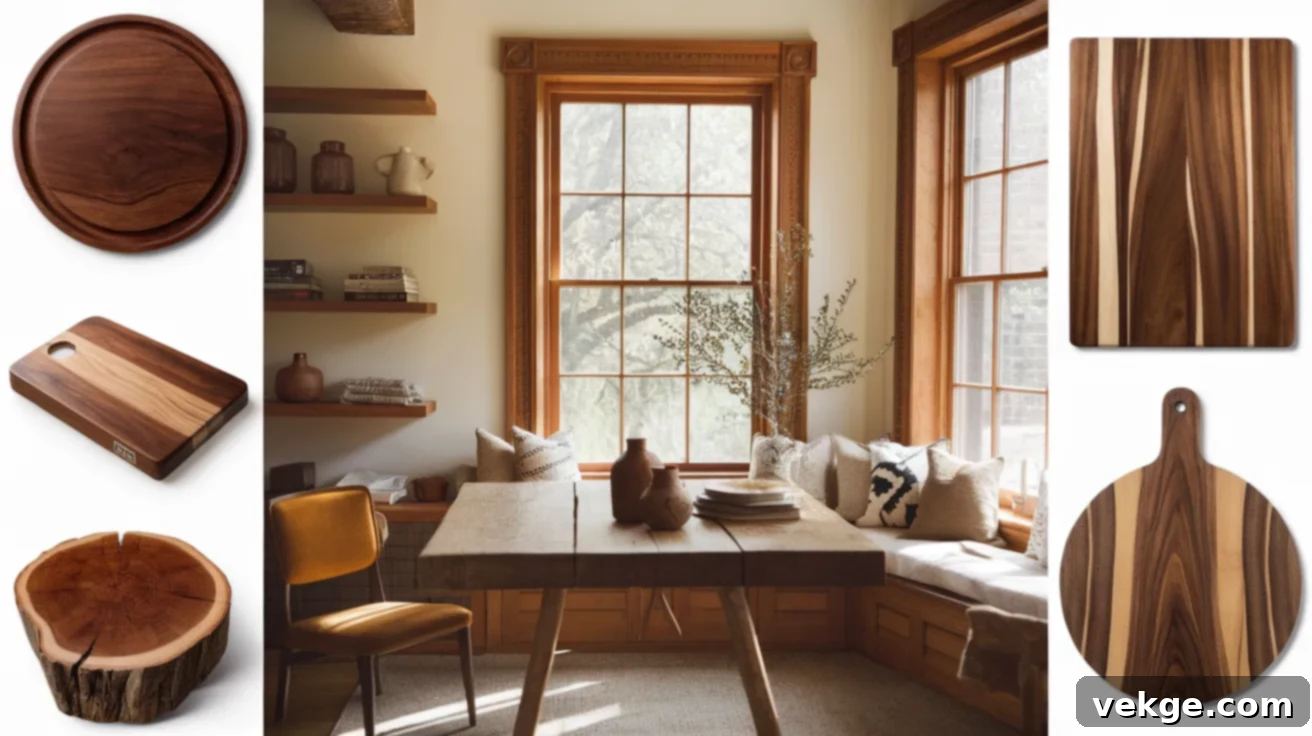
Once you’ve experienced the magic of tung oil on your butcher block, you’ll likely find yourself looking for other wooden surfaces around your home that could benefit from its protective and beautifying properties. Its versatility, combined with its natural, non-toxic nature when cured, makes it an excellent choice for a wide array of applications.
- Cutting Boards: Tung oil is the ideal treatment for all your wooden cutting boards. It penetrates deeply, preventing the wood from drying out, cracking, and absorbing stains and odors, even with frequent washing. Plus, it maintains that beautiful, food-safe surface for all your prep work.
- Wooden Furniture: Give new life to dining tables, chairs, dressers, and bookshelves. Tung oil enhances the natural grain, provides a durable, water-resistant finish, and develops a warm, rich patina over time. It can revive old, dry wood and protect new pieces, making water rings and minor scuffs a thing of the past.
- Wood Trim and Baseboards: Protect the often-neglected wooden trim around your doors and windows, and your baseboards, from scuffs, moisture, and general wear. Tung oil creates a durable, easy-to-clean surface that complements other wood finishes in your home.
- Bathroom Wood Elements: In moisture-prone areas like bathrooms, tung oil is perfect for window trim, shelving, or even wooden vanity tops (if not directly exposed to standing water). Its water-resistant properties help prevent moisture damage and mildew growth, keeping your bathroom wood looking fresh.
- Wooden Toys and Baby Furniture: Given its non-toxic nature when fully cured, tung oil is an excellent choice for wooden toys, cribs, and other baby furniture. Parents can have peace of mind knowing their children are interacting with a safe, natural finish.
- Outdoor Furniture and Decking (covered): While it requires more frequent reapplication for full outdoor exposure, tung oil can be used on covered outdoor furniture or decking to provide natural water resistance and protect against UV damage, prolonging the life and beauty of your patio pieces.
- Wooden Utensils and Bowls: Maintain the integrity and beauty of your wooden spoons, spatulas, and salad bowls. Tung oil keeps them conditioned, prevents drying and cracking, and ensures they remain food-safe and hygienic for everyday use.
- Musical Instruments: Many luthiers and woodworkers use tung oil for its ability to provide a thin, protective finish that allows the wood to resonate freely, enhancing the instrument’s sound while protecting it from environmental factors.
With a little practice, you’ll discover that tung oil is an indispensable natural product for preserving and enhancing the beauty of wood throughout your home.
Maintaining Butcher Block Countertops Finished with Tung Oil: Simple Habits for Lasting Beauty
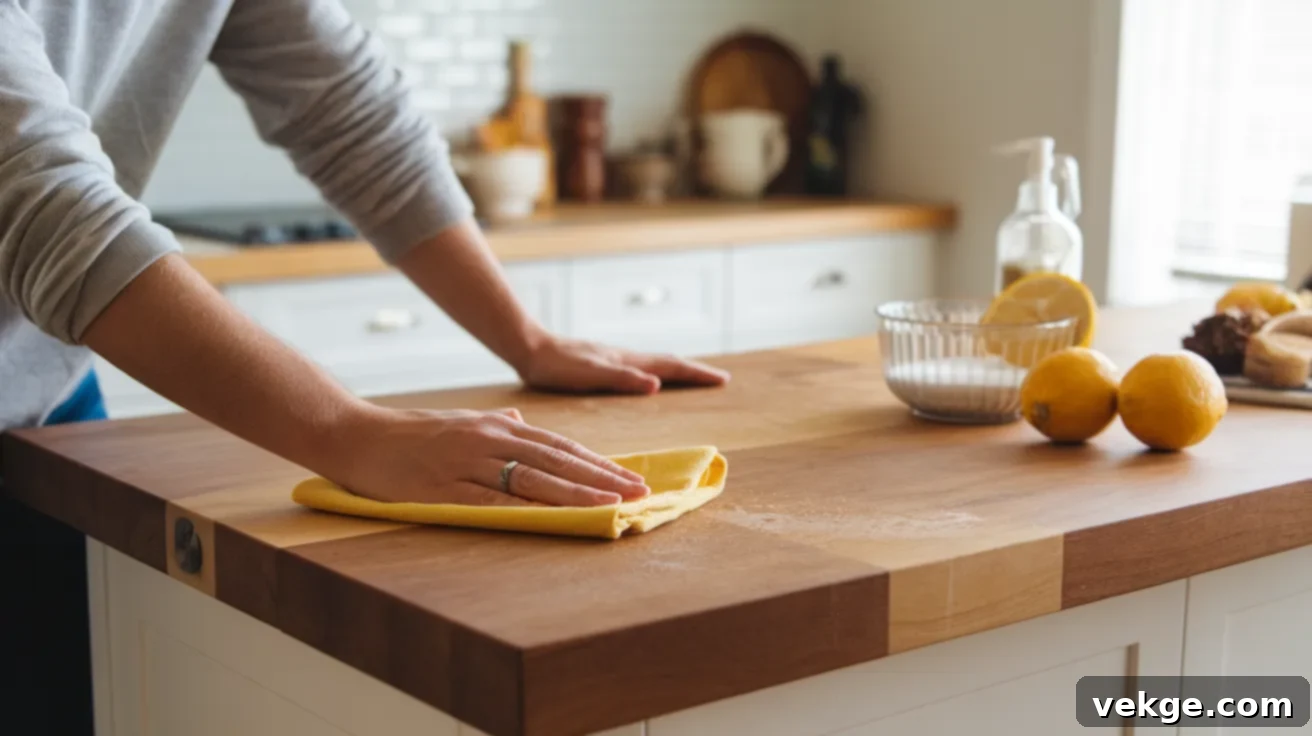
Once your tung oil-finished butcher block is fully cured, caring for it is surprisingly straightforward, requiring just a few regular habits to keep it looking pristine for years. Consistent, gentle attention will ensure your countertops remain beautiful and well-protected with minimal effort.
Daily Cleaning and Stain Prevention
- Gentle Daily Wipe-Down: For everyday cleaning, simply wipe your counters with a damp cloth and a tiny drop of mild dish soap. Avoid harsh chemical cleaners, abrasive scrubbers, or excessive water, as these can strip the oil or damage the wood.
- Prompt Spill Cleanup: Always wipe up spills immediately, especially water or acidic liquids like lemon juice or vinegar. While tung oil provides excellent water resistance, prolonged exposure to standing liquids can eventually penetrate the finish or leave marks. Always dry your counters thoroughly after cleaning.
- Use Cutting Boards and Trivets: To prevent cuts, scratches, and heat damage, always use separate cutting boards for food preparation and trivets or hot pads for hot pots and pans. This protects your beautiful finish from direct abuse.
- Addressing Tougher Spots: For stubborn grime or sticky residues, a mixture of equal parts water and white vinegar can work wonders without harming the tung oil finish. Apply with a cloth, scrub gently, and wipe dry.
- Tackling Stains Naturally:
- For superficial stains (e.g., coffee, wine): Create a paste with baking soda and a little water. Apply it to the stain, let it sit for 5-10 minutes, then gently rub with a damp cloth in the direction of the grain. The mild abrasive action often lifts the mark.
- For deeper stains: Sprinkle some coarse salt over the stain, then rub with half a lemon. The acidity of the lemon combined with the salt’s abrasive quality can naturally lift deeper marks. Rinse thoroughly and dry.
Reapplying Tung Oil: Refreshing Your Protection
Your butcher block will communicate when it’s time for a refresh. The most telling sign is when water no longer beads on the surface and instead soaks in or leaves dark spots. Other indicators include the wood looking dull, dry, or lighter in high-traffic areas. This typically occurs every 6-12 months, depending on usage.
- Simple Refresh Process:
- Clean the countertop thoroughly as you would daily.
- Once completely dry, lightly sand any dull or worn areas with fine 220-grit or 320-grit sandpaper, always sanding with the grain.
- Wipe away all sanding dust with a tack cloth.
- Apply a thin, fresh coat of pure tung oil, just as you did initially. Rub it in, let it soak for 15-20 minutes, then wipe off all excess.
- Allow it to dry for 24-48 hours. Often, a single maintenance coat is sufficient, though a second might be applied for heavily used areas.
This reapplication process is significantly quicker and less intensive than the initial finishing. It’s a wonderful seasonal ritual, allowing you to reconnect with the natural beauty of your kitchen and ensure its continued protection. By following these simple maintenance steps, your tung oil-finished butcher block will not only last for decades but will also develop a richer, more beautiful character with every passing year, truly becoming the heart of your home.
Conclusion: The Enduring Value of Tung Oil for Your Butcher Block
Embarking on the journey of finishing your butcher block countertops with pure tung oil is a decision that truly pays dividends. While it demands a measure of patience, particularly during the initial curing phase, the profound satisfaction of running your fingers across a surface you’ve personally protected and enhanced is a unique reward. Few elements in your home will offer the same blend of tactile pleasure, visual warmth, and functional integrity.
Beyond its undeniable aesthetic appeal, tung oil offers a lasting legacy of protection. It’s more than just a surface treatment; it’s a deep infusion of nature’s best defense, creating a robust, food-safe, and highly water-resistant barrier from within the wood itself. This means your butcher block isn’t merely covered; it’s genuinely fortified, designed to withstand the rigors of daily kitchen life and to gracefully improve with every passing year, developing a richer patina and character that tell the story of your home.
Your butcher block is often the natural centerpiece of your kitchen, drawing eyes and inviting hands. When friends and family gather, admiring your beautifully preserved counters, you’ll feel a quiet pride knowing you chose a finish rooted in centuries of tradition—a finish that upholds the natural warmth and beauty of the wood while ensuring it remains a safe and functional space for creating cherished memories. So, gather your supplies, roll up your sleeves, and give your butcher block the enduring care and respect it deserves. You’ll be thanking yourself with every meal prepared on its resilient, radiant surface.
